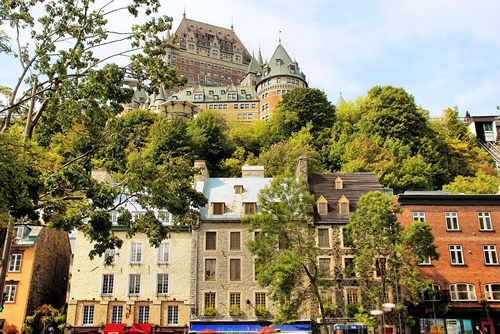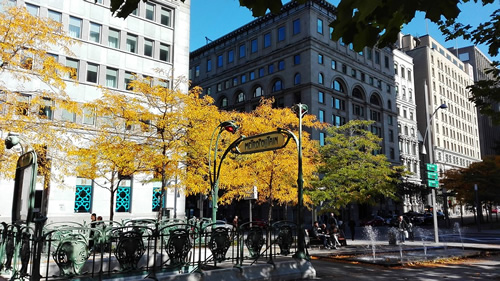The Guide to Visiting Historic Quebec
Discover Another Culture Close to Home
By Alison Gardner
Senior Travel Editor

|
|
A view of old Québec city.
|
Big-city vacationing has always rated low on my travel agenda, that is, until I discovered Canada’s cosmopolitan Old Montréal and the province’s postcard-perfect capital, Québec City. Lively and
engaging in every season, their extensive historic quarters contain dozens of uncommon accommodations, eateries, museums, public markets, galleries, and a year-round schedule of festivals and events that inevitably trigger in me a characteristic
Québecois joie de vivre. These are not historic quarters you visit for a few hours; they are neighborhoods to get to know, where the local people actively share their history with visitors.
With its unique cultural place on the North American landscape, Québec is not a predictably close reflection of its French ancestry. The accent and expression of the language — too frequently dismissed as a sloppy,
incomprehensible version of the mother tongue — evolved in isolation as a result of the settlers’ abrupt disconnection from their European roots when the British took over in 1759.
Thanks to the realistic British concern that their newly-acquired colony would try to join the U.S. during the 1776 American Revolution, unprecedented laws were passed to guarantee use of the French language as well as freedom
to practice the Catholic faith. The result is that Quebec treasures, teaches, and lives its distinctive heritage and culture. It is not uncommon to meet residents who recount their family tree back 12 generations.
A successful effort to rejuvenate the old sections of the province’s two key cities has made them much more than a tourist attraction. They offer a perfect backdrop for a rich cultural, culinary, and language immersion
without ever leaving North America. And despite La Belle Province’s official unilingual status, no visitor is handicapped for lack of French skills.
Old Montréal

|
|
An entrance to the Montréal metro.
|
Annoyingly nicknamed the Paris of the West, this city is nobody’s clone though it is the world's second largest French-speaking city and one of North America’s oldest cities, first settled by colonists in 1642.
Huge effort and expense have been focused on preserving and representing the city’s secular and religious past in an authentic, lively manner. Museums are often the backdrop for creative, colorful entertainments. Actors
in period costume frequently bring history alive; street musicians offer up toe-tapping traditional music; and tour guides dress the part for historic walking expeditions.
Regardless of the season, I can squander happy hours sampling the windows and wares of narrow, inviting streets, stopping to ponder life over a bowl of frothy café au lait or a simple lunch menu. Public markets — with
fresh produce, dozens of delicious local cheeses and meats, and the traditional bagette of crusty French bread — encourage picnics in a sunny square or along the riverfront.
Old Québec
The only fortified city north of Mexico, Old Québec City was acknowledged as a UNESCO World Heritage Site in 1985, one of only three cities in North America to hold that status. The two levels of its historic
quarter create a quite different atmosphere from Old Montréal. The upper plateau was selected first by the French military because it provided ideal natural ramparts against British and native attack. In more settled centuries under
the British, merchants built warehouses and docks in the lower town along the St. Lawrence River itself.
Winding cobbled streets lead the reasonably agile from the upper quarter down to the old port. Alternatively, a glass-wrapped funicular smoothly shunts visitors up and down the steep embankment in two minutes flat.
Even through the winter ice flows, ferries make the 10-minute car and passenger dash across the river, recommended to visitors for the panoramic view of the city’s architectural profile, more truly appreciated offshore.
In recent years, popular museums, public markets, concerts, and world-class festivals like the Carnaval de Québec, have drawn locals and visitors to a vibrant waterfront with its choice of historic accommodations
and eateries: stone-clad and brick warehouses transformed into family-run inns that are winning architectural and tourism awards.
For More Info on Québec
Montréal Tourism; Québec City Tourism.
Both cities offer visitor passports with free and discounted entry to attractions as well as business discounts.
Montreal on Wheels offers guided and self-guided tours of the historic quarter. There are
220 miles of bicycle paths, many radiating from Old Montréal along canal paths, onto other picturesque islands, and through some of the city’s parks.
Transportation: A taxi ride from the airport of either city to its historic quarter is about $30. After that, walking will take care of most attractions. Montréal has a first-class metro/subway
with several stations on the edge of the historic quarter. In Québec City, funicular rides are $1.50 and ferry rides across the St. Lawrence River are $4 per person.
Sleeping with History: Uniquely-furnished and often owner-managed, the many historic hotels and auberges (inns) in the old quarters of both cities have very subtle signage — a historic property
requirement, making it imperative to know your accommodation address.
Stay in Old Montreal
Auberge Alternative Hostel du Vieux-Montréal.
Stay in Old Quebec City
Le Chateau Frontenac, is a 618-room Victorian colossus, notable for its signature profile atop the
city ramparts and for its elegant traditional hospitality. Across a treed square from the Frontenac is the cosy 21-room Auberge du Trésor,
dating from 1679.
|
Alternatives in the Québec Countryside
Quebec’s Eastern Townships lie just north of the Vermont, New Hampshire, and Maine borders, and only an hour’s drive from Montreal. After 200 years of rural prosperity, new residents, and those with
deep family roots, vigorously resist urbanization. Numerous covered bridges, round barns, picture-postcard houses and public buildings, as well as hundreds of churches and family cemeteries decorate the landscape of rolling hills, broad
fertile valleys and well-worn Appalachian Mountains.
At the end of the 18th century, British Loyalists chose colonial governance north of the border over American citizenship in the new U.S. They laid the foundation for today’s architectural heritage, where
well-maintained 100- to 150-year-old structures are commonplace. Both villages and countryside are popular for exploration in all four seasons with guided and self-guided cycling and walking/hiking tour routes clearly defined, and cross-country or downhill skiing in winter.
My favorite spot is the elegant 1802 village of Knowlton on the shore of Lake Brome. Magog and North Hatley run a close second and third. Tree-shaded residential streets roll back the pages of history, while
historic inns and B&Bs, artisan and antique shops reinforce the leisurely disconnection that no city holiday can provide. A picnic of fresh locally-grown and baked delicacies is equally as attractive as country-style gourmet dining
in quaint, restored eateries. Visitors are always welcome at the many heritage and arts festivals.
Getting There
The most flexible way to explore the Eastern Townships is by car.
For More Info
Eastern Townships Tourism
|
|
